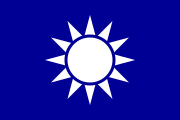
Back Pan-blaue Koalition German Coalición Pan-azul Spanish Pan-sininen liitto Finnish Coalition pan-bleue French Koalisi Pan-Biru ID Coalizione pan-azzurra Italian 泛藍連盟 Japanese 범람연맹 Korean Kelompok Pan-Biru Malay Niebiescy Polish
Pan-Blue Coalition 泛藍聯盟 | |
|---|---|
 | |
| Leader | Eric Chu |
| Ideology | |
| Political position | Centre-right to right-wing |
| Colours | Blue |
| Legislative Yuan | 54 / 113 (48%) |
| Pan-Blue coalition | |||||||||||||||||||
|---|---|---|---|---|---|---|---|---|---|---|---|---|---|---|---|---|---|---|---|
| Traditional Chinese | 泛藍聯盟 | ||||||||||||||||||
| Simplified Chinese | 泛蓝联盟 | ||||||||||||||||||
| |||||||||||||||||||
| Pan-Blue force | |||||||||||||||||||
| Traditional Chinese | 泛藍軍 | ||||||||||||||||||
| Simplified Chinese | 泛蓝军 | ||||||||||||||||||
| |||||||||||||||||||
| Pan-Blue groups | |||||||||||||||||||
| Traditional Chinese | 藍營 | ||||||||||||||||||
| Simplified Chinese | 蓝营 | ||||||||||||||||||
| |||||||||||||||||||
| Part of a series on |
| Conservatism in Taiwan |
|---|
 |
| Part of a series on |
| Three Principles of the People |
|---|
 |
The Pan-Blue coalition, Pan-Blue force or Pan-Blue groups is a political coalition in the Republic of China (Taiwan) consisting of the Kuomintang (KMT), People First Party (PFP), New Party (CNP), Non-Partisan Solidarity Union (NPSU), and Young China Party (YCP). The name comes from the party color of the Kuomintang.
Regarding the political status of Taiwan, this coalition maintains that the Republic of China instead of the People's Republic of China is the legitimate government of China, favors a Chinese and Taiwanese dual identity over an exclusive Taiwanese identity, and favors greater friendly exchange with Mainland China, as opposed to the Pan-Green Coalition.
Cite error: There are <ref group=lower-alpha> tags or {{efn}} templates on this page, but the references will not show without a {{reflist|group=lower-alpha}} template or {{notelist}} template (see the help page).
- ^ "九二共識普拉斯(上):國民黨內部曾提過「華獨」,為何最終沒有採用?". The News Lens (in Chinese). 27 April 2021. Retrieved 15 February 2024.
- ^ "Xi's Top Taiwan Hand Targets 'Hostile Forces' in Taiwan's 'Green' and 'Blue' Camps". Global Taiwan Institute. 12 January 2022. Retrieved 18 September 2024.
Moreover, the blue camp's support for the "status quo," which is tantamount to de facto ROC independence, has been reinforced by the KMT's stated opposition to the "one country, two systems" (一國兩制) formula for unification, which Xi insists upon despite the debacle in Hong Kong. In fact, Wang notes that in its latest political platform, the KMT simultaneously stated its opposition to both "Taiwan independence" and "one country, two systems."
- ^ Kuang-hao Hou, ed. (July 22, 2022). The Social Construction of the Ocean and Modern Taiwan. Taylor & Francis. ISBN 978-1-000-62302-4.
- ^ [1][2][3]